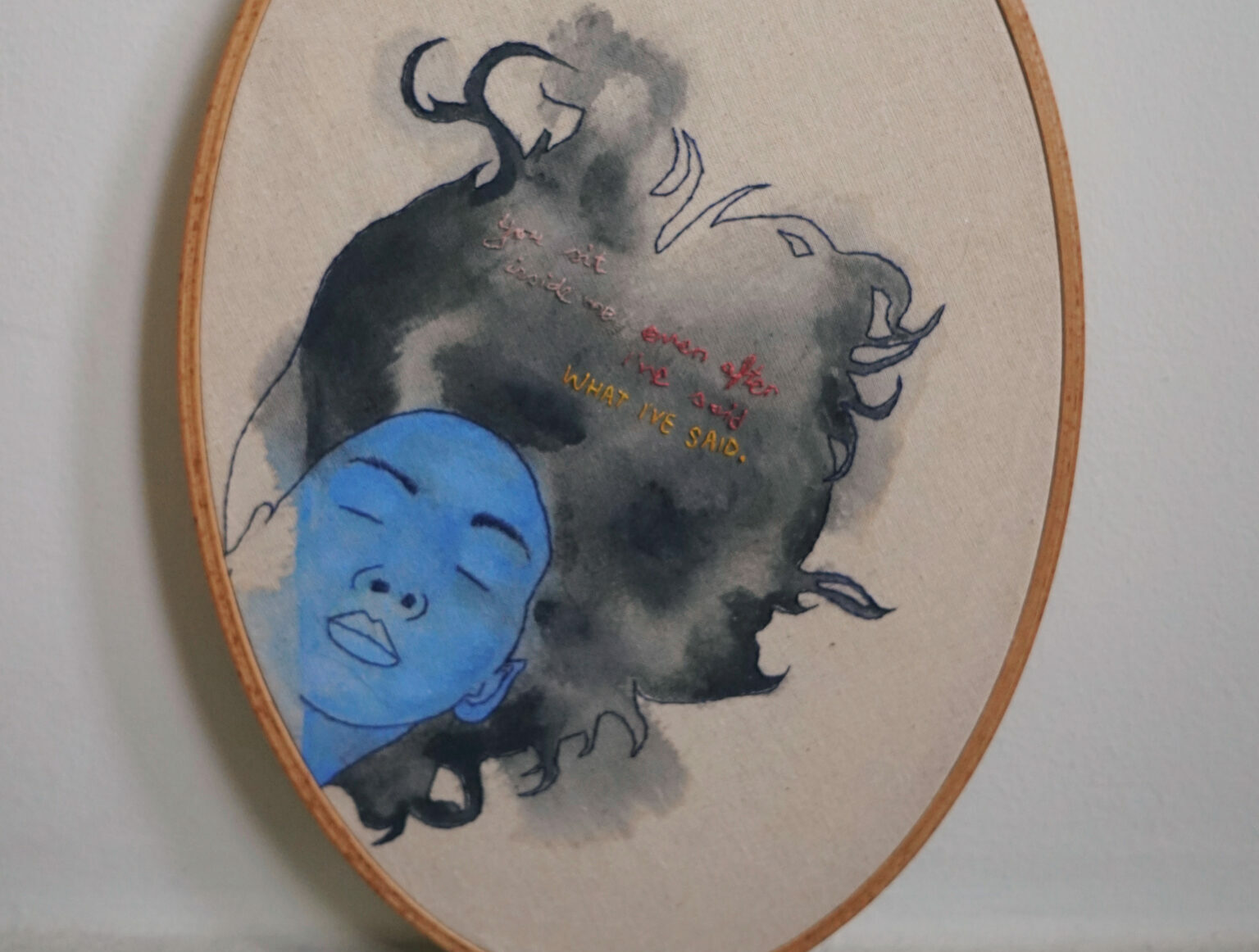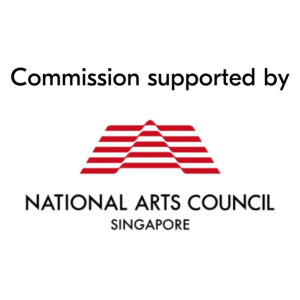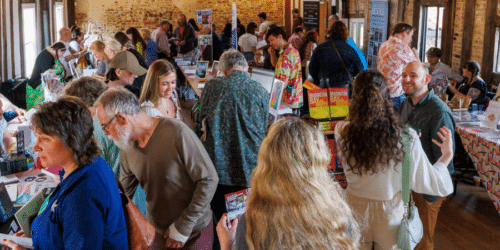
In June 2021, we welcomed three writers and translators from Singapore in virtual residence in Norwich, with the support of the National Arts Council of Singapore. During her residency, Singaporean writer, archivist and educator Jennifer Anne Champion explored textile traditions in Singapore and Norwich, to see how this may translate into her poetry.
Portrait
This film poem reflects on the process of sewing a portrait of my late grandmother. Five portraits were made in total to shoot one poem and each version of my grandmother, brought me a different memory – some kind, some not, all tender.
The values and attitudes to womanhood and ageing that my grandmother passed to me were ultimately quite mournful and stern. I felt judged from beyond while making this piece and my superstitiousness kicked into high gear. I took every precaution such as only knotting in loops of 3 or 5 to avoid the number 4 – which in Chinese culture sounds like the word for ‘death’. While my grandmother has already passed on, I did not want to remind her spirit of its current state.
Embroidered portraiture also makes you keenly aware that you are putting a sharp object through someone’s face. I found myself uttering ‘sorry’ every time I pricked the cloth although the audio of this is not on the film.
The sad, respectful mood of this poem is also complemented by instrumental music from Singaporean artists Subhas Nair and Fauxe for which the artist is thankful.
I start with your eyes,
nervous as I poke needle through iris.
Through soul that has left
but whose spirit
I call into focus.
Still nervous, I risk
removing the feeding tube
that lived in your left nostril.
A foreign object succeeds
when it is no longer clear who is the parasite.
It feeds you and you feed it
until one of you is dry. I
connect nose to jowl. To pocket,
heavy with words unsaid.
Promises and compromises your heart
would not make
but that were ready to leap off your tongue,
if only you were kinder.
Now your ear which I know is just thread on cotton
but I’m certain has gotten the gift of hearing beyond.
Elsie, can you hear me?
I’m sorry I’m using your first name but there must be so many
grandma ghosts where you are
all tittering about what the grandchildren
wearing their faces are doing.
Elsie, I am sorry.
I’m working on your scalp now.
Pricking where I used to brush
your powdered shave releasing a fine mist.
How you’d choke and our eyes would dart
back to the Suria channel when it was safe again.
By now, I have made it to your mouth.
It’s warning stroke, a thinning tide dragged out
lower than any ebb
on a June evening.
And it’s mole on the left lip.
An inheritance from a long line of photocopies.
I’m not an apple far from your gravity.
This mole on our lip. Less north star,
more falling debris.
My lovers say it is beautiful
now
but one day they too will watch a slow drama by my bed,
tolerating exactly one episode.
This mouth, grandma.
I will not wait to say all it needs to say.
Before sewing it all in place.
Download the full collection of Jennifer’s poems and embroidery here (PDF) →
Artist statement
During the course of my virtual residency at the National Centre for Writing I worked on eight poem/embroidery projects of which there were several iterations. Some were passable – enough to be displayed as you see here – and some in my view were duds. It is unfortunate, heart-breaking even, if you have spent both time on the poem and an extra week or so embroidering along with it. But this is the nature of creation – some work is a still birth. Nevertheless I appreciate the time and space the National Centre for Writing afforded me in making mistakes but also producing some successes.
First let me speak on my duds. Two pieces particularly come to mind. My piece on Lorina Bulwer’s samplers and a piece I call ‘Girls and Trees’.
The Bulwer sampler was 1.5 metres long (approximately the same size as the original work) and was a blackout poem done in yarn. I do not include it not because I do not like the poem but I question my execution of it. I had intended to connect but also play with the work of a historical figure and Norfolk resident (Lorina Bulwer) but wondered if my sense of play was ultimately disrespectful. When the original intent of a work is strong, proclamatory and yearning to be visible in its own right, this is a power you should not play with unless your concept is equally strong and compassionate. Nevertheless, a reading of the poem I created can be found in a panel with other artists inspired by Bulwer in the Meet The World series.
Of ‘Girls and Trees’, in my research into embroidery culture I came across the repeated ‘tree of life’ motif in several global textiles. For a week or so, I stewed in mythic ideas of girlhood and trees. In my part of the world, we are told the spirits of women who die in childbirth (also known as pontianak) are bound to trees. Growing up, I was told particularly to avoid the frangipani and banana tree of which there are many in Singapore. In Europe too, there is the Christian tree of knowledge, the Greek myths of girls turned into trees for their own protection and strikingly in my mind, the scene in Shakespeare’s Titus Andronicus where Lavinia has her arms and tongue brutally cut off and replaced with twigs – turning her symbolically into a tree. I had intended to write a poem on this which is half-complete. I completely lost my nerve however with the embroidery which although complete does not quite resemble what I intended.
Perhaps I may make good on these themes and ideas some day. But onwards to my successes.
I am particularly proud of ‘To The Idealists’ which saw six poem revisions on a subject dear to me. As a mixed race Singaporean, I am invested in race relations but find it very difficult to write on this given how tense the subject and mood is here in my country. As of the time of this writing, our prime minister recognised the importance of addressing racism in our recent national day rally given the spate of high profile incidents that happened this year. However, as a majority race individual and highest paid politician in the world, he also saw it fit to call Chinese privilege ‘baseless’.
I marvelled at how polite commenters on the news were in correcting the prime minister and see that restraint in my own poem. By the end of the revisions my poetry group, ATOM, had told me I had gone from too explicit to too vague. I don’t know what balance is required especially of a poem that may not change status quo. It is a perennial question if poetry can change the world. But I do know my intention with creating it was always to provide relief to the right people. I am glad the poem exists and perhaps after this residency it can grow further. Certainly these tensions of ideals are not going away soon with the continual and exacerbated racism and xenophobia seen worldwide due to the pandemic.
I am also quite pleased with ‘Portrait’ and its various experiments in this series which are still works-in-progress and not pictured. There is an intimacy more apparent to me in embroidering the faces of people I know, closely and less tangibly, than there is to rendering them in poems. Mid-way through the residency I started a call on my social medias for pictures of eyes from my followers. Two panels of eyes are complete with a third on the way and I have yet to decide if I should write a large poem or a small one. But I know the subject matter will revolve around attention, privacy and the diffusion of gaze in our current times.
To add an embroidery component to poetry composition is to add a visual and conceptual layer to work which I have still yet to execute beyond an ekphrastic level. Conceptualising takes time which I had plenty of, but it also take thoughtfulness nurtured in communal environments which I did not always have and neither do any of us in these uncertain times. Still there is a longing to connect and to bring pleasure to an audience. I hope to continue doing that long after this residency.
Jennifer’s residency was generously supported by the National Arts Council of Singapore.


Jennifer Anne Champion is a Singaporean writer, archivist and educator of mixed heritage. She is the author of two poetry collections and has been published in the Quarterly Literary Review of Singapore, Esquire magazine and her national newspaper, The Straits Times. Her prose was also published in The Epigram Books Collection of Best New Singapore Short Stories edited by Cyril Wong in 2016.
Jennifer started writing poetry in 2013 and became a regular voice in the spoken word scene with around 15 slam wins under her belt before publishing A History of Clocks and Poems Read Aloud (Redwheelbarrow Books, 2015) and Caterwaul (Math Paper Press, 2016). She has since been focussing on teaching spoken word and the literary arts in public and international schools in Singapore. Jennifer is also a co-founder of poetry.sg and served as its Multimedia Editor from its inception to 2019. During her time, she helped expand the collection from poetry in English to include Malay and Chinese works.
Jennifer’s current interests lie in the intersections of textile art and the written word. A recent and avid embroiderer, Jennifer used her virtual residency with the National Centre for Writing to explore textile traditions in Singapore and Norwich and to see how this may translate into her work in poetry.
Read five pieces of useful writing advice from Jennifer Anne Champion →
Read Jennifer’s virtual walk around Norwich here →
Watch Jennifer in conversation with Mariko Nagai (Tokyo) and Sally-Anne Lomas (Norwich) here →
You may also like...
Crafting identity in fiction with Michael Donkor
In this episode of The Writing Life podcast, we speak with novelist Michael Donkor about how to craft identity when writing fiction.

8th April 2024
Writing subversive women with Naomi Wood
In this episode of The Writing Life, we speak with award-winning author Naomi Wood about writing subversive, malicious women.

25th March 2024
Independent publisher? Apply to exhibit at the City of Literature Publishing Fair
Our popular Publishing Fair returns for Norfolk & Norwich Festival 2024!

12th March 2024






